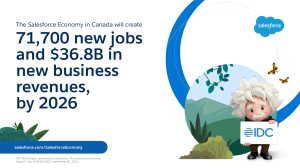Canadian businesses have tackled so many challenges and uncertainties over the last 18 months that they deserve some good news about the future — and it doesn’t get much better than the data in a new study from market research firm IDC.
In The Salesforce Economic Impact, IDC forecasts that Salesforce and its ecosystem of partners in Canada will create 71,700 new jobs and $36.8 billion in new business revenues by 2026. The study also finds that Salesforce is driving immense growth for its partner ecosystem in Canada.
According to Margaret Stuart, Canada Country Manager for Salesforce, the IDC study provides proof that the investments businesses have been making in digital technologies are not only paying off but promise long-term success for companies of every size.
“There is tremendous momentum behind the Canadian Trailblazer community of customers, partners, and developers who power the Salesforce Economy,” Margaret said in response to the study, which also includes data from around the world. “This ecosystem is fueling innovation and contributing to top economic priorities, like job creation and empowering the essential digital transformation of Canadian businesses looking to succeed today and in the future.”
What is the Salesforce Economy?
IDC defines the Salesforce Economy as the impact of Salesforce customers and its partner ecosystem on business revenues, as well as direct and indirect job growth.
The Salesforce Economy is truly global, offering Canadian companies the same opportunity to participate in programs and initiatives that create jobs and help fill them. In fact, a Tableau visualization of the IDC data shows that Canada will generate $8.08 in partner revenue alone for every dollar of Salesforce revenue over the next five years.
Economies thrive when those working within them make the best use of their resources, and the Salesforce Economy is no different. To understand what this means for individual Canadian businesses, it may be best to zoom in on one of the biggest shifts taking place within companies today.
Building digital HQs solves for urgent transformation needs
Many Canadian companies started off running their business from a traditional headquarters at a fixed address. As they continue to adopt technologies like the cloud, however, a new pattern is emerging.
The businesses that grow the most and the fastest are those that have shifted to a digital HQ — a model whereby they can manage their team and deliver outstanding experiences to customers from anywhere by breaking down silos, streaming communication and empowering collaboration. It can also help prepare them to make a positive contribution towards sustainability and to combat climate change.
According to IDC, for example, the migration from on-premise software to the cloud in the next three years could reduce as much as 1 billion metric tons of CO2. This aligns with Salesforce’s recent announcement that it has achieved net-zero across its entire value chain and reached 100 per cent renewable energy.
That’s probably why, according to IDC’s customer survey, 39% of Salesforce customers surveyed look to Salesforce as a source of support in reaching their own sustainability objectives.
Salesforce partner ecosystem drives worldwide acceleration of growth
Of course, developing a digital HQ might seem daunting to companies who are still in the early stages of this journey. The IDC study is a good reminder, however, that it’s not a journey they have to take on their own.
The partner ecosystem is a critical pillar of the Salesforce Economy because it helps level the playing field in terms of who can set ambitious digital transformation goals and achieve them.
As a country largely made up of small and medium-sized businesses (SMBs), for instance, Canada benefits enormously from resellers, system integrators, consultants and other specialists in Salesforce products and services. These are the partners who can bring forward new ideas and develop approaches based on best practices learned on projects they’ve done for similar customers.
No wonder, as the IDC data shows, global partner ecosystem revenue has grown from $4.50 for every dollar of Salesforce revenue last year to $5.55 today.
Salesforce paves pathways to help unlock career opportunities in the Salesforce Economy
A lot of Canadian SMBs don’t have dedicated IT resources, but that doesn’t mean they’ll be left behind.
For years now, Salesforce has been helping to address those needs with Trailhead, a free platform where learners from anywhere can earn globally recognized credentials, including newly-introduced roles such as Marketer, Sales, and Designer.
The release of the IDC study is a great reminder for Canadian companies to consider how they’re developing their team and closing any potential skills gaps.
How Salesforce is creating jobs to fuel the Salesforce Economy
The growth in jobs IDC is projecting as a result of the Salesforce Economy will also require significant investments in talent. That means companies will need to find new hires who know how to use tools like a CRM solution, marketing automation and even artificial intelligence to support data-driven decision-making.
Enter The Salesforce Talent Alliance, an initiative that connects partners to job candidates trained on Salesforce via Trailhead and brings new talent into the fast-growing ecosystem. There are many other resources, such as Salesforce AppExchange, which can help Canadian companies accelerate their connection to the Salesforce partner ecosystem by browsing the world’s leading enterprise cloud marketplace.
As more businesses recognize the promise and potential of the Salesforce Economy, the IDC study suggests an important call to action. The jobs and the revenue are coming. Now is the time to be a part of the future as it unfolds.

























